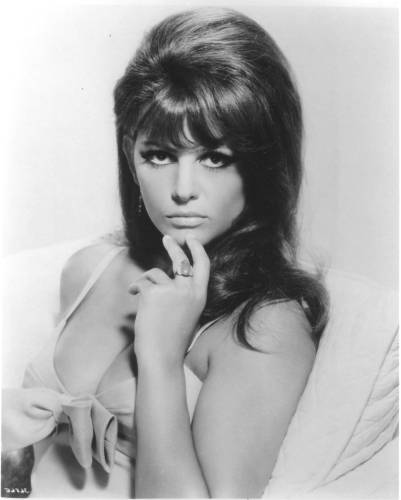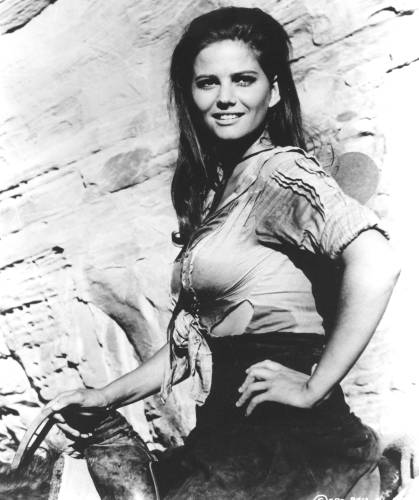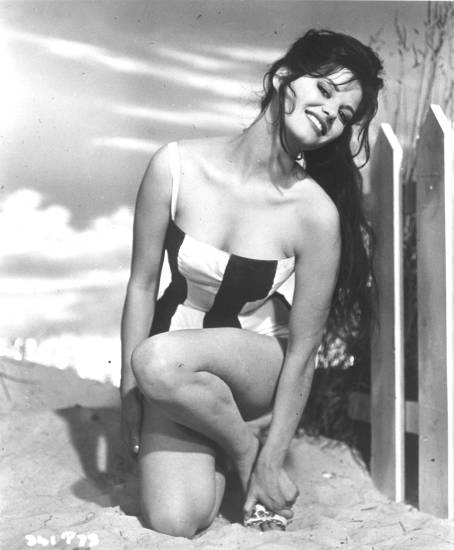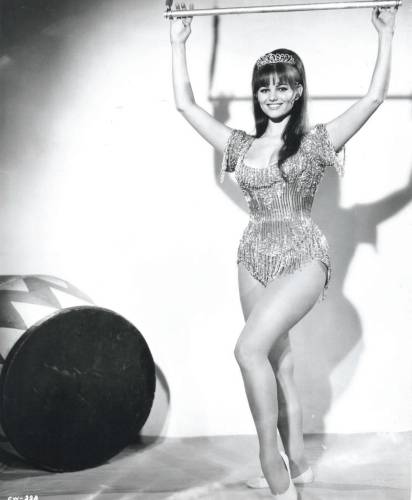
|

|
CLAUDIA CARDINALE

In the seventies, a tobacco company once boasted that smokers would walk a mile for one of their cigarettes.
Well, I'll be damned if I'm gonna wear out a good pair of Jordans for a cancer stick. However, I'd have crossed the
Sahara Desert to enjoy the pleasures of Tunisia's most fondlesome flower, Claudia Cardinale. With no disrespect to the
more popular sophia Loren and Gina Lollobrigada, in my humble opinion, Claudia was the most exotic and invigorating of
the major Italian glamour girls of the fifties and sixties. With her signature raspy voice, large innocent schoolgirls'
eyes and lusty Renoir figure, the amatory powers of Claudia Cardinale were potent to say the least.
Born in Tunis, Tunisia, Africa, Claude Josephine Rose Cardinale was the product of a French mother and Italian
father. Growing up, Claudia had ZERO aspirations for a movie career. By the age of eighteen, she had enrolled
in college to become a teacher. It would take one of those true-to-life Hollywood circumstances to turn this future
grade school marm into one of the sexiest actresses to grace the silver screen. "I was going to college to teach young
children, when they organized a kind of charity day." She told the Los Angeles Times. "I was helping my mother
and people from the Italian government organize an Italian film festival in Tunisia. I was looking at the girls on the
stage and I wasn't suppose to be there. Someone pushed me out on the stage and I was named the Most Beautiful Girl in
Tunisia." Her prize was a trip to the Venice Film Festival, an excursion which would change her life forever.
|

|

|

|

|

While in Rome, she was enrolled in the Centro Sperimentale acting school, however after a short
period, Claudia became bored with acting and decided to return to Tunisia. Fortunately, for us, the Italian film industry's
persistence paid off and she was persuaded to return to Italy. In 1958, she signed a tong term contract with famous
producer and director Franco Cristaldi. The producer's influence extended beyond her screen career, as the two quickly
became lovers (and eventually husband and wife). Claudia would find herself not only obligated to Cristaldi as his
wife, but he would also weld a heavy controlling hand on her film career. He induced her to sign a very restrictive
contract, one reminiscent of those used during the old Hollywood studio days. Claudia was forbidden to cut her
hair, marry or gain weight. Cristaldi himself, would select any and all pictures she was to star in. Scandal
was out of the question, as proven in 1959, when Claudia had a "mysterious affair" which produced a child out of
wedlock. She was coaxed into introducing the boy as her brother instead of as her son. Despite his Svengali mentalilty,
to Cristaldi's credit, he masterfully placed Claudia in some of Italy's most critically acclaimed films. Claudia would
learn her craft under some of Italy's greatest directors.

Claudia's first major film would be I Soliti Ignoti (Big Deal on Madonna Street USA
title), directed by the great Mario Monicelli in 1958. A hilarious comedy about a band of bungling burglers, the movie
went on to win the Oscar for Best Foreign Film. More hit films followed: Un Maledetto Imbroglio (The
Facts of Murder) in 1959 placed her under the direction of Pietro Germi (Divorce - Italian Style).
1960 saw her ignite the screen in Valerio Zurlini's La Ragazza con la valigia (Girl With a Suitcase).
A film filled with superb symbols of rigid social structure and discrimination, Claudia was well up to the task of carrying
this metaphoric film. Suddenly, her star was illuminating brighter and brighter and across Europe. Her
face and lovely figure would be seen on dozens of magazine covers. However, it is ironic to
note that as her popularity was rising, one of Claudia's most treasured assets had yet to be revealed on screen (no,
not those assets), that of her sexy, raspy voice. Initially, it was believed that her natural gritty vocals
would be a turn off to movie goers primed on the silky tongues of Lollobrigida and Brigette Bardot. Claudia faced the
first real dilemma in her career. Despite the fact she had starred in several successful films, none of those films
featured her real speaking voice. No one questioned her screen presence, however, would audiences still adore her
after hearing her? In the 1930's after the advent of sound in films, many silent screen stars faded away due to comical
or poor speaking voices that didn't fit their sceen persona. Would this be Claudia's destiny as well? In 1963,
Director Luigi Comencini decided to gamble that audiences would adore Claudia's vocal uniqueness as much as her beauty and
charm. So, five years into her career, Claudia's real voice was finally heard in Comencini's La Ragazza di Bube
(Bebo's Girl). Comencini's roll of the dice paid off as the film became a critical
hit. Claudia, voice and all, was now on her way. Her next stop; working for the master himself, Frederico Fellini.
|

|

|

|

|
In the acclaimed film 8 1/2, Claudia plays the mythical "perfect woman" in what is basically Fellini's
personal autobiography. A riveting display of symbolisms and self-destructive nihilism, Fellini would garner the Oscar
for Best Foreign Film in 1963. With two Academy Award winning movies on her resume, Claudia was finally ready for
her American screen debut. Cristaldi couldn't have selected a better vehicle to introduce Claudia to American audiences
then the Blake Edwards comedy, The Pink Panther. Starring opposite the inimitable Peter Sellers, Claudia
is at her finest, playing well off the rascally Sellers and affirming that all that fine training under the Fellini's and
Monicelli's was not in vain. In the film she plays Princess Dala, owner of the Pink Panther diamond.
Claudia plays the role with a nice blend of clever comedic timing as well as her usual sexy, sensual screen presence.
America loved Claudia, raspy voice and all, and more english films followed. In 1964 she held her
own opposite legends John Wayne and Rita Hayworth in Circus World. In Blindfold, Claudia was matched
with Rock Hudson, and their on-screen chemistry is what keeps this some-times tedious film interesting. Claudia
would then star, in my opinion, in the two best westerns of the sixties The Professionals in
1966, and Sergio Leone's Once Upon a Time in the West in 1968. In 1969, A Fine Pair would reunited
her with Hudson, with Claudia at her coquettish best as a jewel thief who of course, steals Rock's heart. It wouldn't be a stretch to say that Claudia was easily Rock Hudson's best on-screen partner behind Doris Day.

While her career was ascending, Claudia's personal life was spiraling toward disaster. Her marriage
to Cristaldi had gone sour years ago. "For more then 15 years I was considered and treated like an object or a project
to be manufactured and merchandised." She would tell the L.A. Times in 1975. The two divorced that same year.
Claudia returned to Italy, where the bulk of her film work would be shot. Her only major American ventures would be
the 1977 miniseries Jesus of Nazareth, in which she plays the fallen adulteress brought before Jesus by a blood thirsty
mob. 1979's Escape to Athena was disappointing and amaturish and a waste of Claudia's talent and time.
Beyond her film life, Claudia found love again in the arms of director Pasquale Squitieri. The two
never married, but have lived together for over thirty years, producing one child, a daughter. Pasquale would also adopt
Claudia's son as his own. As she has matured, Claudia has lent her voice to several humanitarian causes. She has
become a vigilent spokesperson for UNESCO (United Nations Educational, Scientific and Cultural Organization) and has fought
to improve the living conditions and educational opportunites of girls and women of Mediterranean countries.

Looking back over her career, it has been said that Claudia Cardinale was a distant third to Loren and Lollobrigida
in regards to film achievements. It has also been said that Claudia was merely a Bardot clone, playing on sex appeal
alone. While many feel that Claudia was nothing more then Franco Cristaldi's pawn, and deserved none of the credit for
her career. However, I'd argue strongly in Ms. Cardinale's defense on all three counts. First of all, on
the charge that Claudia couldn't hold a torch to Loren and Lollobrigida, I say, examine Claudia's body of work, film against
film. She has been in far more important and influential films then either of the two L's. Secondly,
for those who assert that Claudia was just Italy's answer to Bardot, a sex kitten with little else to offer, I implore
you to take a look at her gritty prostitute-turned wife in Once Upon a Time in the West, or her comedic prowess in
The Pink Panther and then tell me that she didn't have more depth in her little finger then Bardot. And finally,
I beg to differ with those who charge that she was merely Cristaldi's marionette. True, he may have pulled the
strings that launched and sustained her career, however, it was Claudia's radiant screen presence and talent that held
viewers in awe. It was those hypnotizing brown eyes, sexy, sultry looks and yes, that gorgeous raspy voice that left
fans as spellbound then, as we still are today.
CHECK OUT PAST SPOTLIGHT ON...DOLLS!
|

|

|



